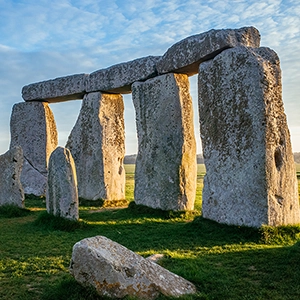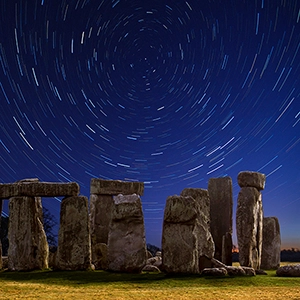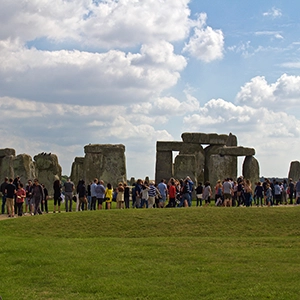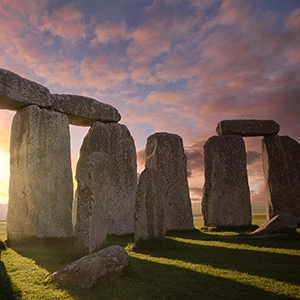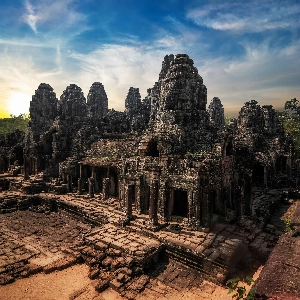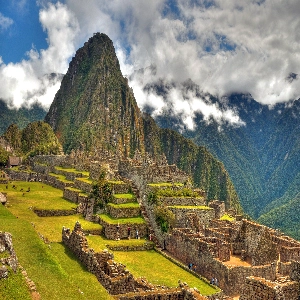Experience Stonehenge: Step Back In Time 5,000 Years

Still the subject of speculation as to its true reason for existing, Stonehenge, located at Salisbury Plain in Wiltshire, England, is presumed, among other things, to be a sacred place, and is an utter marvel of engineering, given that it was built from solid stone between 3000BC and 2000BC, before humankind possessed any large vehicles for moving such huge monoliths.
The circle of standing stones at Stonehenge vary somewhat in size, and a few have lintels stretching between them, but most are freestanding and measure 4 metres (13 feet) high and 2.1 metres (7 feet) wide. They weigh about 22.7 tonnes (25 tons). How did the ancient people who built Stonehenge get the rocks to the location? This is one of the many mysteries of Stonehenge that continue to draw visitors and modern-day Pagans to this amazing sacred place.
Now designated an UNESCO World Heritage Site, Stonehenge boasts a tourist centre, and has undergone some reconstruction and restoration work for the sake of preservation. At one time, crowds of tourists were so dense, they had to be restricted. People were trying to chip bits of the stones for souvenirs. The site is monitored carefully these days.
What is Stonehenge? Academics continue to speculate and postulate about the origins and purpose(s) of Stonehenge. It is both typical and atypical of a Neolithic monument, and yet bones have been found that prove people came from as far away as present-day Italy (then a major journey) to the site. Here are a few of the educated guesses as to the use of Stonehenge:
Given all those options, it is also possible that Stonehenge was built for one reason and then “repurposed” over its 5,000-year life. Indeed, it is the mystery of Stonehenge that keeps it at the forefront of amazing sacred places on earth.
- a burial ground
- a temple of worship
- a symbol of peace and unity between perhaps warring ancient tribes
- a form of ancient calendar; the sunset on the winter solstice and sunrise on the summer solstice align between two of the rocks
- a place of healing (which could explain the copious number of bones; doctoring was guesswork back then)
- a possible winter home for the locals
- a ritual path from life to death for the old or dying (what remains is not all that was on the site initially)
What Was Stonehenge Used For?
Stonehenge, one of the world's most famous and enigmatic monuments, continues to mystify scholars and tourists alike. Built approximately 4,000-5,000 years ago in the English countryside, its purpose has been the subject of speculation and research for centuries. Theories abound, with popular propositions including an astronomical observatory, a site of religious rites, a symbol of social unity, a place of healing, or even an ancient acoustic marvel. The exact answer to 'What was Stonehenge used for?' remains elusive, but the multitude of theories illuminates the complexity and diversity of prehistoric human life, painting a fascinating picture of our distant past.
Unraveling the Mystery: Who Built Stonehenge?
Stonehenge, the monumental prehistoric stone circle in England, is a testament to human ingenuity, perseverance, and cultural complexity. But who were its architects? The exact identity of Stonehenge's builders remains a mystery, but archaeological evidence indicates that it was likely the work of Neolithic and early Bronze Age inhabitants of the region. Constructed in several stages spanning centuries, Stonehenge bears the marks of a society capable of complex organization and large-scale projects. While speculations have linked the monument to various ancient civilizations and even legendary figures, contemporary scientific consensus attributes it to the indigenous prehistoric inhabitants of the British Isles. 'Who built Stonehenge?' remains a question that, while elusive, offers fascinating insights into the capabilities and cultural practices of our ancestors.
Unlocking the Mystery and Myths of Stonehenge
Stonehenge, a prehistoric marvel in Wiltshire, England, has long been at the heart of human fascination. This ancient circle of megalithic stones, erected thousands of years ago, continues to beguile historians, archaeologists, and visitors alike. Despite extensive studies, its purpose remains enigmatic, shrouded in mystery and countless myths. From celestial observatory to sacred healing site, numerous theories aim to unlock Stonehenge's secrets. Each myth and interpretation adds another layer to our understanding of the people who erected this awe-inspiring monument. This article ventures into the heart of Stonehenge's riddles, offering a glimpse into the ancient world's mind and spiritual life, challenging us to unravel the timeless enigma this monument presents.
Where Is Stonehenge And How To Get There?
Stonehenge, a world-renowned prehistoric monument, stands in the beautiful county of Wiltshire, in the South West of England. The nearest city is Salisbury, located approximately 9 miles to the south. To reach Stonehenge, you can take a direct train from London to Salisbury, then hop onto the Stonehenge Tour Bus for a seamless journey. Alternatively, driving from London takes about 2 hours via the M3 and A303. Once there, you'll be captivated by the monumental stone circle, a testament to the engineering skills of Neolithic humans. A visit to Stonehenge promises a fascinating journey into the past, offering insight into the lives and cultures of our ancient ancestors.
Unveiling the Wonders: Fascinating Facts About Stonehenge
Stonehenge, an awe-inspiring prehistoric monument located in Wiltshire, England, is an architectural marvel that continues to captivate the world. Erected between 4,000 and 5,000 years ago, its construction represents a remarkable feat of human ingenuity and determination. Despite its ancient origin, it is strikingly aligned with the sun's path, signifying a keen understanding of astronomy. Additionally, the presence of human remains and artefacts in the surrounding area points towards its usage as a burial ground and possible ritual site. Moreover, the sheer enormity and precision of Stonehenge, with some stones weighing up to 30 tons, suggests a society with advanced organization skills. The myriad facts about Stonehenge provide a window into our ancient past, inspiring wonder and fostering an appreciation of human history.


